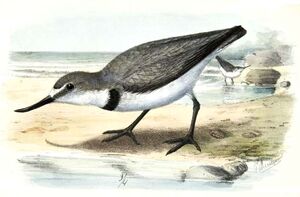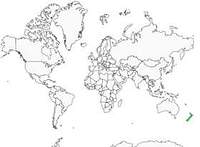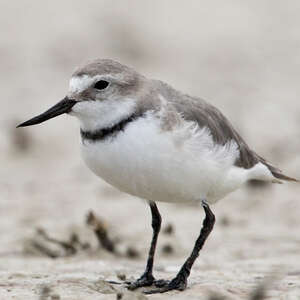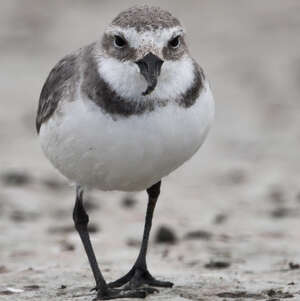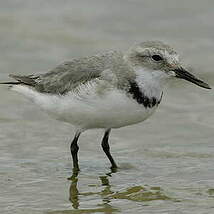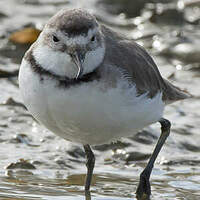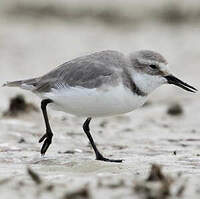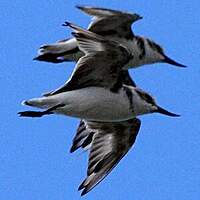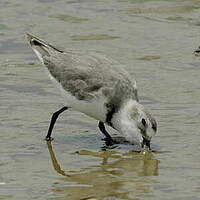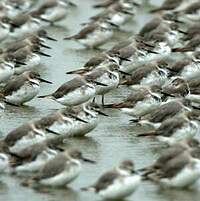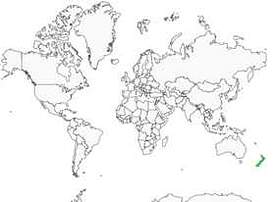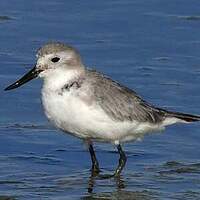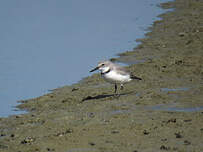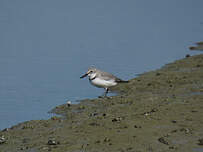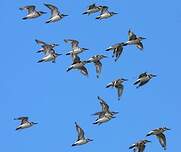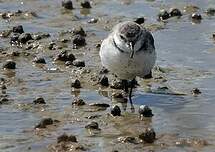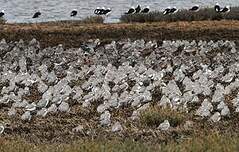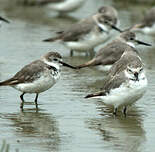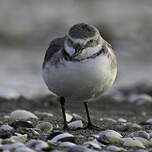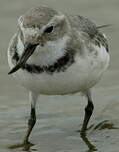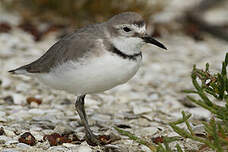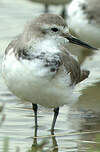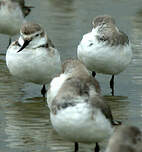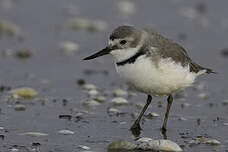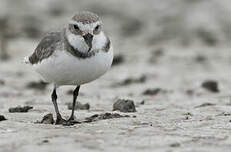Wrybill
Anarhynchus frontalis - Pluvier anarhynque
Identification
What a curious bill! The tip of the black bill of the Wrybill is always curved to the right. No one has ever seen one with its bill turned to the left. But this peculiarity is only really visible under good observing conditions. I have noticed that when viewed from the side, the curve is not that obvious; viewed from the front it is clearer. The top is light grey and the bottom white, making it almost invisible on banks of silt or sand when it is motionless. In their nuptial plumage, both the male and female have an a fine black collar, which is wider in the male. The male also has a thin black stripe on its forehead. The legsa re a grey-green colour. When in flight, viewed from above, the bird appears grey. A whitish band at the base of the primary remiges is more or less visible. The sides of the rump are also marked with white. Intermediate adult birds and juveniles do not have the black collar.
Subspecific information monotypic species
Foreign names
- Pluvier anarhynque,
- Chorlitejo piquituerto,
- borrelho-de-bico-torto,
- Schiefschnabel,
- ferdecsőrű lile,
- Scheefsnavelplevier,
- Beccotorto,
- snednäbb,
- Skjevnebblo,
- kulík krivozobý,
- kulík křivozobý,
- Skævnæb,
- kieronokkatylli,
- corriol bectort,
- skrętodziób,
- Кривоносый зуёк,
- ハシマガリチドリ,
- 弯嘴鸻,
- snednäbb,
- 彎嘴鴴,
Voice song and call
Habitat
In the breeding season, the Wrybill inhabits in New Zealand (where it is endemic) the same habitat as the Little Ringed Plover (Charadrius dubius) in ours.
Behaviour character trait
The Wrybill is thus a migratory bird, but a short distance migrant (several hundred kilometers). It moves along the eastern coastline of the country and observations of migrating birds inland are rare. They are not shy birds and we were able to approach to within a few meters, on the mudflats where they were feeding, without disrupting them.
Flight
Dietfeeding habits
The Wrybill is an insectivore. Its main prey are mayflies and their larvae as well as other small invertebrates. They also eat fish eggs. On river banks, their curved beaks allow these birds to collect their food under stones without having to turn them over. However, on the mudflats where they winter, they catch their prey in the same way as other sandpipers, but are mostly obliged to tilt their heads.
Reproduction nesting
The breeding season lasts from August to January. Wrybill couples settle on gravel bars surrounded by running water, defending their territory. The nest is, like the little stint, a shallow cup dug in gravel. The bottom is lined with several dozen small stones. The female lays two eggs. The young are nidifugous and subject to significant predation by the Kelp Gull (Larus dominicanus) that frequent the same habitats.
Threats - protection
IUCN conservation status
concern
in the Wild
threatened
evaluated
By the end of the 20th century, the population of the Wrybill was estimated to be between 3,000 and 5,000 individuals. It is slowly but steadily declining. The main causes are hydro engineering works, riverbank riprapping and the development of aquatic recreational activities. Predation by introduced Ermine Mustela erminea and cats also play a role. The development of populations of black-backed gulls poses a sword of Damocles over this small endemic wader. The species has been protected since 1940 and doesn't seem to suffer from poaching. BirdLife International has classified it as vulnerable.
Sources of information
- IOC World Bird List (v15.1), Gill, F and D Donsker (Eds). 2025-12-07.
Other sources of interest
 Specification sheet created on
02/08/2023 by Georges Olioso
Specification sheet created on
02/08/2023 by Georges OliosoTranslation by AI Oiseaux.net
© 1996-2025 Oiseaux.net
- Accipitriformes
- Aegotheliformes
- Anseriformes
- Apodiformes
- Apterygiformes
- Bucerotiformes
- Caprimulgiformes
- Cariamiformes
- Casuariiformes
- Charadriiformes
- Ciconiiformes
- Coliiformes
- Columbiformes
- Coraciiformes
- Cuculiformes
- Eurypygiformes
- Falconiformes
- Galliformes
- Gaviiformes
- Gruiformes
- Leptosomiformes
- Mesitornithiformes
- Musophagiformes
- Nyctibiiformes
- Opisthocomiformes
- Otidiformes
- Passeriformes
- Pelecaniformes
- Phaethontiformes
- Phoenicopteriformes
- Piciformes
- Podargiformes
- Podicipediformes
- Procellariiformes
- Psittaciformes
- Pterocliformes
- Rheiformes
- Sphenisciformes
- Steatornithiformes
- Strigiformes
- Struthioniformes
- Suliformes
- Tinamiformes
- Trogoniformes

